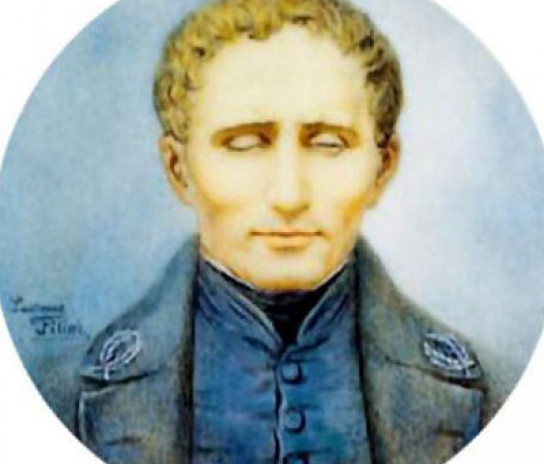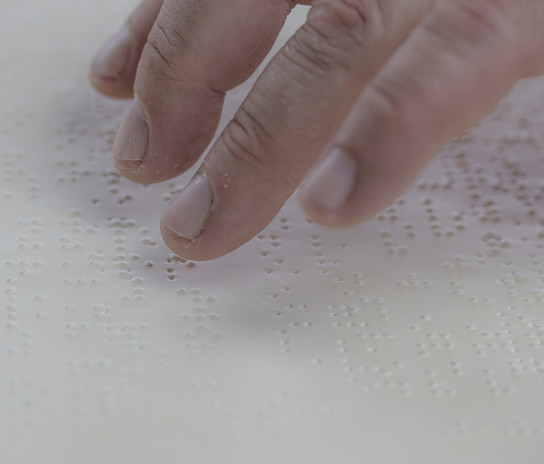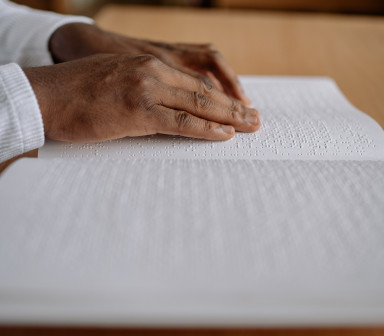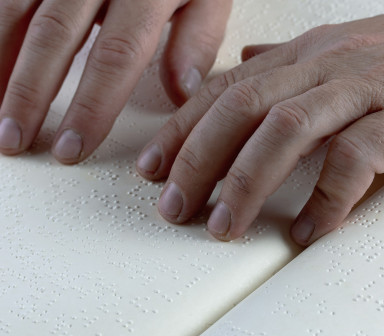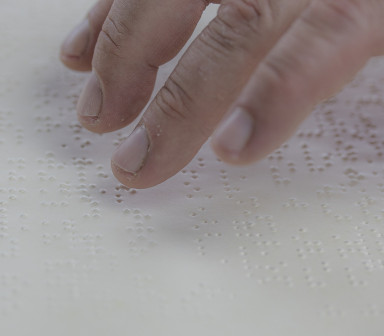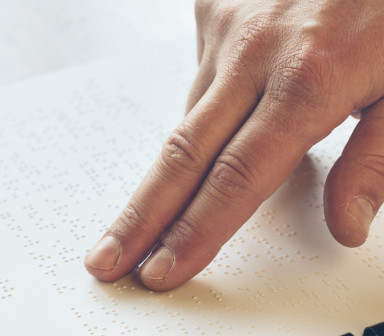This National Braille Week (11 – 17 October 2021) we’re sharing stories about Braille and accessible formats. Jim McCafferty was a braille proof reader at our Scottish Braille Press for a number of years. We are extremely grateful that, following retirement, Jim continues to support us as a supply braille proof reader. He is also a Trustee of the UK Association for Accessible Formats (UKAAF).
Jim has shared an informative introduction to Braille which we hope you’ll find interesting.
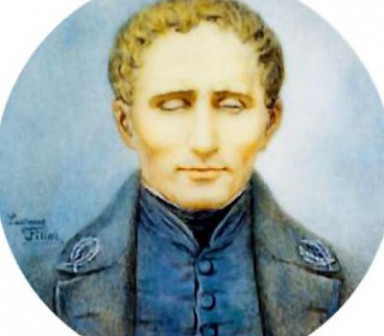
What is braille?
Long before Louis Braille’s time, attempts had been made to create embossed letters or shapes on wood or paper to enable the visually-impaired to read by touch. After the Napoleonic Wars, a French artillery officer named Charles Barbier invented "night writing", which used raised dots on cardboard to send written messages on battlefields by night. It was this military system that Louis Braille adapted for the visually-impaired. In 1819, when he was 10, he was accepted at the Institute for Visually-Impaired Children in Paris.
In the 1820s it occurred to Captain Charles Barbier that his system could be used by the visually-impaired. He took it to the school where Louis Braille was one of the pupils enlisted to evaluate it. The students found it interesting, but too rudimentary to be of much value to them. It inspired Louis, however, to work out an improved system of his own, which he completed in 1824 at the age of 15. After laborious trial and error he simplified Barbier’s method, using six dots in varying patterns in domino-like "cells", which provided a total of sixty-three permutations for different letters and numbers, and later musical notes. The sixty-fourth permutation, with no dots at all, was the space symbol.
The other pupils at the school took to Braille’s method. Its simplicity made it easy to learn. Braille became a teacher at the school himself in 1826 and published his method three years later in a typically modest 32-page book, entitled Method of Writing Language, Plain Chant and Music, by Means of Raised Points for the Use of Blind Persons. It was printed in embossed text.
He produced an improved version of his system in 1837 and Pierre Foucault, another visually-impaired ex-pupil of the school, invented what was in effect the first typewriter for the visually-impaired in 1841.
The Braille system, which enables visually-impaired people to read and write, was introduced to the United Kingdom in the latter half of the 19th century. Following a conference held in Edinburgh in 1905 there was a major reform of the system. Another such reform took place in 1932, by which time the system was known as Standard English Braille.
What's happening with standards?
In 2011 UKAAF, after consultation with the braille reading public, took the decision to implement Unified English Braille (UEB). The concept behind UEB is that braille can be standardised in English-speaking countries where it is used, thus enabling an easy interchange of files electronically. Those countries include Australia, Canada, Ireland, New Zealand, South Africa, United Kingdom and the United States of America.
Standards for producing braille are constantly being developed, including those for mathematics and music. Similarly print symbols are often debated, nationally and internationally, with a view to replicating them in braille. UEB is therefore much more versatile, and to date, symbols include those for Bold, Italics, Underline, the Copyright and Trademark signs and the Tick mark.
The rule book for UEB is regularly reviewed and updated. It is available as a print, online electronic or braille document, the latter running to several volumes.
What important technological developments are happening with braille?
Throughout the evolution of braille various methods have been developed to produce it. To begin with there was the hand writing frame, where each dot was laboriously punched out. A number of braille writing machines were designed and invented but probably the most widely used is the Perkins. Introduced around 1950 it has stood the test of time.
Since the 1980s attempts have been made to introduce devices which produce braille electronically. I first came across the Braillewriter in 1984. This had limited memory but, at the time, it was revolutionary.
Currently I use the BrailleNote, which allows me to create documents in various file formats, keep details of addresses, appointments, etc, and both send and receive emails. I can also access the Accessible Library Trust website to download books. Most of the electronic devices for producing braille are very expensive. More recently however some low-cost devices have been introduced, such as the Orbit Reader and Braille Me. They use either Duxbury or LibLouis software translation programs.
How the Royal Blind School use BrailleNote devices
How is braille being used?
Since its development innumerable uses for braille have been devised. Firstly it allows visually-impaired people to read for pleasure: magazines such as "Progress", first published by RNIB in the 1890s, as well as UKAAF's `Format Matters`. In addition, both classic and contemporary novels have been and continue to be produced, together with reference books and instruction manuals.
To assist with the education of visually-impaired people some specialist codes have been devised, such as Mathematics, Music and some Foreign Languages. Personal documents, such as financial statements and utility bills, are regularly available. In the home, braille can be used for personal documents or useful labelling such as electrical chargers. Most importantly, braille allows visually-impaired people to remain independent and involved in their communities.
A very welcome use of braille in recent years has been its being produced on the packaging for pharmaceutical products. Increasingly it is appearing on supermarket products, both comestible and domestic, in lifts and on trains. Airlines too often have braille safety instructions for visually-impaired passengers. Museums and other exhibitors, who allow visitors with a visual impairment to examine exhibits by touch, often have details in braille.
What is the future of braille?
Braille codes are continually reviewed and developed to make them more compatible with print. More learning and teaching materials will also be enhanced, thus making braille readily available to visually impaired people.
For me the future of braille really does look bright. When I first learnt to read and write I never dreamt for one moment that I would be using a device like a BrailleNote to write this article. Whilst at school I was taught by a number of visually-impaired teachers, and I often think how much easier, and more rewarding, their job would have been if they had had the use of technology available to me.
Finally there is the introduction of low-cost braille displays such as the Orbit Reader and Braille Me, which make electronic devices much more affordable for visually impaired people. Who knows what may be just around the corner?
